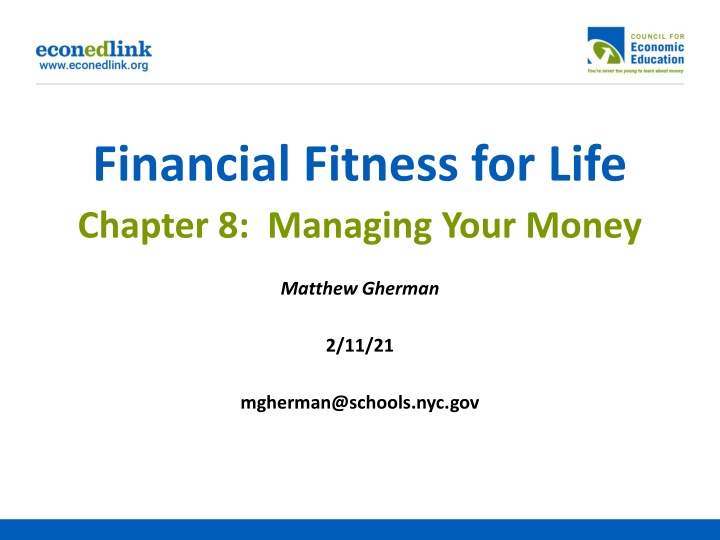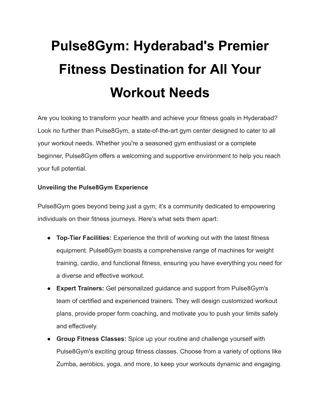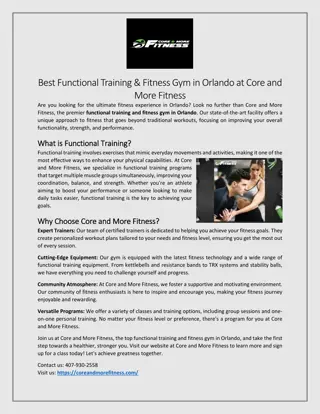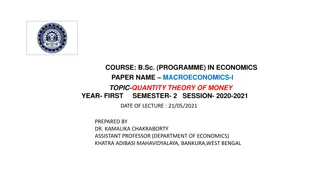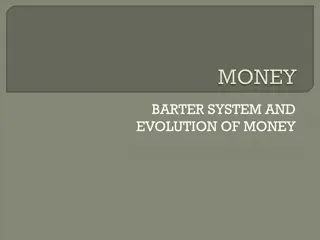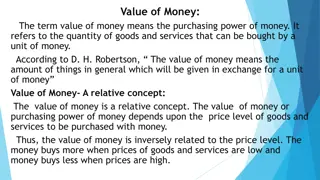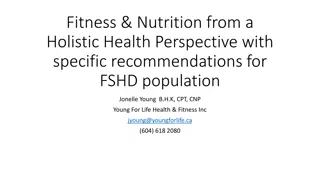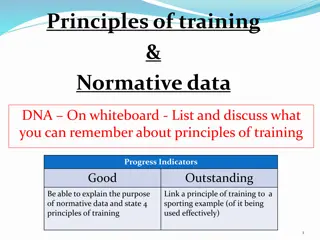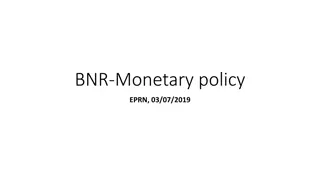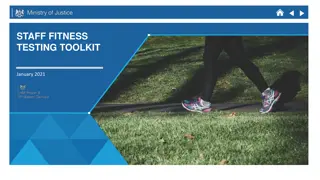Financial Fitness for Life - Chapter 8: Managing Your Money
Explore key budgeting terms, learn about budgeting, and evaluate budgeting decisions. Understand elements of a monthly family budget, apply cost-benefit concepts, and discover national and state standards related to budgeting. Access activities and resources for effective money management.
Download Presentation

Please find below an Image/Link to download the presentation.
The content on the website is provided AS IS for your information and personal use only. It may not be sold, licensed, or shared on other websites without obtaining consent from the author.If you encounter any issues during the download, it is possible that the publisher has removed the file from their server.
You are allowed to download the files provided on this website for personal or commercial use, subject to the condition that they are used lawfully. All files are the property of their respective owners.
The content on the website is provided AS IS for your information and personal use only. It may not be sold, licensed, or shared on other websites without obtaining consent from the author.
E N D
Presentation Transcript
Financial Fitness for Life Chapter 8: Managing Your Money Matthew Gherman 2/11/21 mgherman@schools.nyc.gov
EconEdLink Membership You can now access CEE s professional development webinars directly on EconEdLink.org! To receive these new professional development benefits, become an EconEdLink member. As a member, you will now be able to: Automatically receive a professional development certificate via e-mail within 24 hours after viewing any webinar for a minimum of 45 minutes Register for upcoming webinars with a simple one-click process Easily download presentations, lesson plan materials and activities for each webinar Search and view all webinars at your convenience Save webinars to your EconEdLink dashboard for easy access to the event You may access our new Professional Development page here
Professional Development Certificate To earn your professional development certificate for this webinar, you must: Watch a minimum of 45-minutes and you will automatically receive a professional development certificate via e-mail within 24 hours. Accessing resources: You can now easily download presentations, lesson plan materials, and activities for each webinar from EconEdLink.org/professional-development/
Agenda Introduce the basics basics of money management Activities Activities for learning about budgeting and key vocabulary Activities for creating and evaluating budgeting decisions decisions
Objectives The student will identify and explain the meaning of key budgeting terms such as disposable income, family budget, variable expense, fixed expense, balanced budget, and net worth. Identify the elements of a typical monthly family budget including income, expenses, and savings. Apply the concepts of costs and benefits to the budget-making process.
National Standards Standard 2.5: A budget includes fixed and variable expenses, as well as income, savings and taxes Standard 2.6: People may revise their budget based on unplanned expenses and changes in income.
State Standards R.10 -- Read and comprehend complex literary and informational texts independently and proficiently. W.9 Draw evidence from literary or informational texts to support analysis, reflection, and research. L 9.10 Acquire and use accurately general academic and domain specific words and phrases, sufficient for reading, writing, speaking, and listening at the college and career readiness level; demonstrate independence in gathering vocabulary knowledge when considering a word or phrase important to comprehension or expression.
Watch the video and answer the following questions https://player.vimeo.com/video/239510067 Questions: Why do we need to have a budget? (elicit study of scarcity) What are three types of goals you may have? (elicit short, medium, long) How can you adjust your budget to achieve a goal, if your expenses are too high?
Have students read and highlight the handout Review: What are the issues in the opening paragraph? Three steps help to address these issues?
Ask for five students to volunteer to participate in a call-in show activity about budgeting. Determine which of the volunteers will play the roles of: Budget Bob, Dr. Penny Saver, Connie from Connecticut, Calvin from California, and Minnie from Minnesota Have the students read the script in front of the class. There is also part for All to involve all of the volunteers and/or the entire class if you desire.
What is disposable income? (Disposable income is the money you have left to spend or save as you wish after all required deductions [e.g., taxes, Social Security, retirement plan contributions] have been taken out of your gross pay.) What does Dr. Saver recommend as the three parts of a family budget? (A family budget should include a listing of income, expenses, and savings. Some students may note that savings can be included as part of family expenses. This is one way to make sure that a family makes a commitment to saving.) What are fixed and variable expenses? Use examples to illustrate each. (Fixed expenses are ones that are relatively constant each month, such as a house payment, rent payment, and car payment. Variable expenses are ones that are likely to change or can be changed in the short term. Examples include telephone bills, groceries, medical bills not covered by insurance, entertainment, recreation, and charge account purchases.)
What does pay yourself first mean? (Some savers include their savings goal in the fixed expenses part of their budget. This means that they make a commitment to saving in the same way that they are committed to paying expenses like car and house payments.) What is net worth? (Net worth is a measure of wealth. It is the current value of assets minus liabilities. [Liabilities are debts you owe.]) What is meant by a balanced budget? (A balanced budget occurs when monthly expenses are equal to monthly income. If expenses are greater than income, the budget is negative. Certain expenses may not get paid or the person may go into debt to pay them.)
Instructions: Give each student a copy of John and Marcia: Monthly Spending Plan. Ask the students to read the background information about John and Marcia and then answer the follow up questions
Who are John and Marcia? (A young, married couple working to support one child.) What is their lifestyle? (They live in a comfortable apartment, enjoy some small luxuries, and keep up with all their bills.) What is their immediate financial goal? (To save enough money for a down payment on a second car.)
a. What are some examples of John and Marcias fixed expenses? (Housing, life and disability insurance, renter s insurance, automobile insurance, student loans etc.) b. What are some examples of John and Marcia s variable expenses? (Meals, utilities, automobile fuel, medical care, child care, clothing, etc.) c. John and Marcia have decided to practice the pay yourself first approach to saving for a second car. How do they pay themselves first? (They have the amount that they want to save taken out of their pay and automatically deposited into their savings account, as if they were paying off a fixed expense.) d. Examine John and Marcia s monthly spending plan. What sacrifices do you think John and Marcia should make in their variable expenses to meet their goal? Note: at- home food expenses can t be reduced below $220. e. What are the benefits and costs of your recommended decisions for John and Marcia?
Instructions: The goal of the exercise is to use the information provided to determine whether John and Marcia can afford to buy a $150,000 home. Ask the students to read the exercise and answer the questions. Discuss the answers as a class.
a. What would the monthly payment be for John and Marcias home loan? $150,000 - $10,000 = $140,000; $140,000 loan at 6% interest = $840 for PI (principal & interest) b. What would John and Marcia s total house payment be, including PITI? $840 (PI) + $210 (TI) = $1,050 (PITI) c. Using the two lending criteria, would John and Marcia qualify for the loan they are considering? Yes. $5,400 x .28 = $1,512; the monthly PITI is expected to be only $1,050; $5,400 x .36 = $1,944; John and Marcia s monthly PITI ($1,050) plus other consumer debt [car loan and credit card payment of $430] is only $1,480
d. Do John and Marcia have enough flexibility in their budget to accommodate the additional costs of homeownership (mortgage payment, taxes, insurance, and higher utilities)? Not right now. Their total expenses will be $5,500, representing fixed expenses of $3,240 and variable expenses of $2,260. They will need to adjust some of their variable expenses to balance their budget. They might find it difficult to purchase new home furnishings and appliances. If they experienced an unexpected financial setback, such as the loss of a job, they might be unable to make payments on their home loan. e. What are the benefits and costs of your recommended decision for John and Marcia? The cost is that John and Marcia will not be able to become homeowners now. The benefit is they will not have to sacrifice activities they would like to do now.
Bankrate.com Plug their information into loan calculator to see full amortization schedule: a table that lists each regular payment on a mortgage over time. A portion of each payment is applied toward the principal balance and interest, and the mortgage loan amortization schedule details how much will go toward each component of your mortgage payment https://www.bankrate.com/calculators/mortgages/amortization- calculator.aspx https://www.econedlink.org/resources/budget-odyssey/
Follow up Research Please use the following articles as well as your own research to answer the questions that follow Part 1: Living on Your Own: Part 1: Living on Your Own: https://www.suzeorman.com/start-here https://www.youtube.com/watch?v=v_8W58LMHrs&feature=emb_logo https://www.thebalance.com/what-s-the-difference-between-fixed-and-variable- expenses-453774 https://www.thebalance.com/how-to-make-the-most-of-your-first-job-paycheck-1289812 https://www.thebalance.com/stop-paycheck-to-paycheck-2385520
Follow up Research Please use the following articles as well as your own research to answer the questions that follow Part 2: Getting Ready for Home Ownership: Part 2: Getting Ready for Home Ownership: https://www.thebalance.com/how-to-buy-your-first-home-2385826 https://www.thebalance.com/how-amortization-works-315522 https://www.thebalance.com/do-i-really-need-a-down-payment-when-i-purchase-a- home-2385808 https://www.daveramsey.com/blog/financially-ready-to-buy-home https://www.investopedia.com/mortgage/insurance/ https://www.investopedia.com/financial-edge/0411/5-things-you-need-to-be-pre- approved-for-a-mortgage.aspx
1) What should you have financially in place for you to move out on your own? 2) What is the difference between variable and fixed expenses? 3) What questions should you think about when looking for an apartment? 4) What does living paycheck to paycheck mean? Why is this not ideal? 5) Find an apartment rental listing in the city you would like to live in after you graduate from college. How much is your monthly rent? 6) Make an itemized list with prices of furniture you will need to start out (go to the Ikea website). What else will you need to start out (microwave, hangers, curtains, etc.)? Overall, approximately how much money will you need initially to live on your own? 7) What is the minimum wage in the state you would like to live in after college? How many hours of minimum wage will you need to work to pay for your rent? 8) What is good budgeting advice to live by yourself comfortably?
1) What is a mortgage? 2) What is a pre-approval? 3) What percentage of the mortgage should the down payment be? Why? 4) What is an amortization schedule? 5) What is a PMI (private mortgage insurance)? 6) What fees/expenses besides the mortgage is involved in owning a home? 7) What should you financially have in place before you buy a home? (credit score, savings, etc.)
Follow the step by step process on https://www.honomobo.com/us/ho3 and calculate how much it would be to build your own home!
CEE Affiliates https://www.councilforeconed.org/resources/local-affiliates/
